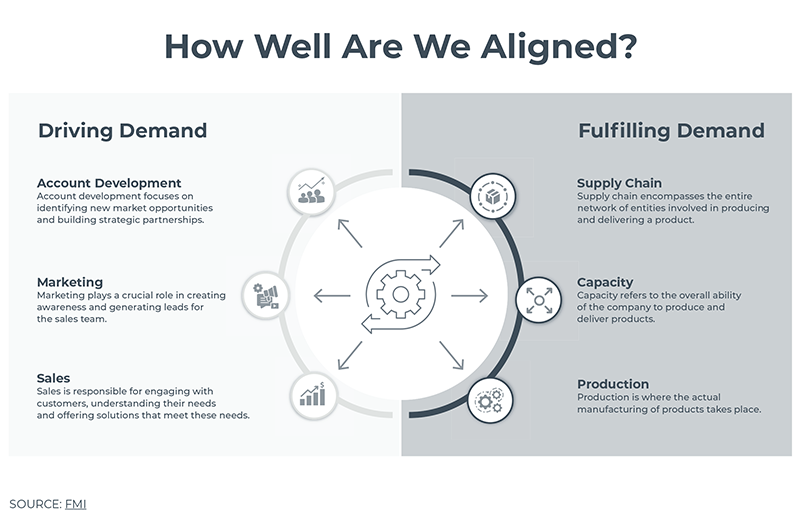Why Informed Leadership Is a Must for Building Product Manufacturers Looking to Align Teams

A critical factor influencing the success of building products manufacturers is the alignment between the teams focused on driving demand (account development, marketing and sales) and those responsible for fulfilling demand (supply chain, capacity and production).
Learning how to make this alignment a reality can be daunting, causing many to avoid doing the work it takes.
The disconnect between driving demand and fulfilling demand has been more pronounced since the COVID-19 pandemic, as sales teams are pressured to transition from being order takers to proactive drivers of market share. This gap exacerbates operational inefficiencies that stymie manufacturers’ abilities to meet market demand effectively, limiting companies’ capacities to achieve revenue growth and capture market share and highlighting the need for strong leadership to bridge these gaps.
Strong leadership through intentional vision setting, communication and people development plays a pivotal role in capturing market share, growing revenue, fostering alignment and enabling organizations to thrive in a competitive landscape.
“Building a visionary company requires 1% vision and 99% alignment,” wrote author Jim Collins in his book, co-authored by Jonas Porras, “Built to Last: Successful Habits of Visionary Companies.” And building product manufacturers are no exception. Building product manufacturers need to create alignment between driving demand efforts and fulfilling demand activities to achieve long-term success.
Vision as the Bedrock of Internal and External Alignment
To set the foundation for a successful, enduring and aligned organization, leaders must first embark on defining the vision to align employees, decisions and future directions with the organization’s culture and goals. This vision is comprised of two key elements:
- Core purpose and core values
- Long-term strategic goals
While financial success is essential for any profitable organization, companies must first clarify their core purpose and core values. For example, Ferguson Enterprises states its purpose is to “help make our customers’ complex projects simple, successful and sustainable.” The “why” behind the business—the single driving force with which everything in the organization aligns—is focused on setting customers up for success.
Take, for example, the business’s growth strategy, which is directly related to its purpose. Ferguson has more than 36,000 vendors in its network, making it easy for customers to get the products they want. The network provides the added benefit of diversifying Ferguson’s revenue by spreading risk and costs across vendors.
Ferguson’s location strategy also reflects its purpose of reducing complexity. With 95% of customers located within 60 miles of a Ferguson store in North America, the company is able to deliver with more ease and sustainability what customers need on a timeline that sets them up for success.

By defining core values, or the principles and beliefs that guide behaviors, decision-making and culture, the company developed a framework for how it interacts with employees, customers and other stakeholders. Ferguson also lives its core value of service by offering after-hours customer service and support. The company is known for working with customers to solve problems, even if it’s been years since their last purchase.
Defining a clear purpose and core values not only sets the stage for internal alignment within an organization— it also attracts external partners and clients who agree with the guiding principles. When the organization’s purpose and values are widely upheld, publicly stated and fully integrated into operations, they serve as a key differentiator—emphasizing shared values and helping to build long-lasting relationships through trust.
This is crucial in the building products space as new products and competitors enter the market. Ultimately, organizations that demonstrate alignment with a strong vision for their external partners and clients are shown to have higher revenues, profits, and valuations than organizations that do not have an aligned strong vision.
This uptick in profitability comes in part from aligned teams that are driving and fulfilling demand. Without a clear purpose and set of core values, decision-making becomes reactive or disjointed, because there are no guiding principles to evaluate priorities or choices. With a clear core purpose and core values, the organization has a filter through which to test all decisions.
In the absence of these guiding principles, companies may pursue short-term or contradictory goals, creating internal competition or detachment, that leads to wasted resources and diminishing competitive advantage. It can also lead to a lack of intentionality in the organization’s selection of external partners and clients to work with or different experiences depending on how clients interact with the firm. This presents a host of financial, operational and cultural issues.
Moreover, the core purpose offers a company a foundation for resilience during periods of uncertainty or disruption. Without a core purpose organizations may struggle to navigate challenges, take advantage of market opportunities, or stay engaged and productive in times of change and uncertainty.
While having a clear core purpose and core values provides a foundation for alignment, it is incomplete without identified long-term strategic goals. All employees need to understand who the company is, why it exists, how to behave and the organizational direction.
A lack of strategic goals creates disconnected teams and silos that often work against each other. Companies often experience lower engagement and morale when people don’t understand how their work is contributing to the broader mission and future objectives, especially when there is a lack of connection and communication from leadership.
This is exhibited well when we look at a European building products manufacturer managing U.S. facilities. Without direct communication, oversight and leadership presence in the U.S., the teams became disconnected, and productivity levels dropped from lack of alignment. There wasn’t clarity around what priorities were key for success and what metrics were used to define it. This negatively affected the company’s relationships with important clients and external partners.
Primed for Success
In summary, to set your organization up to thrive, your leaders need to:
- Clearly define the organization’s core purpose, core values and strategic goals to set the stage for alignment, internally and externally.
- Establish protocols to communicate vision and strategy across all levels of the organization.
- Integrate core values into team meetings, decision-making processes, sales pitches and all customer interactions to strengthen internal and external alignment.
- Link individual and departmental goals to the organizational vision.
- Ensure that reward systems emphasize the company’s purpose, values and long-term strategic goals.
- Communicate regularly with their teams to ensure employees feel supported, get their questions answered and experience high morale. This can be as simple as scheduling regular site visits or being intentional about spending time together.
Communicate, Communicate, Communicate
While a strong vision sets the stage for alignment, communication is the true key in bridging the gap between driving demand and fulfilling demand in building product manufacturing companies. When there are a clear communication strategy and systems in place, the demand side (sales, marketing) and fulfillment side (operations, supply chain) can collaborate effectively to ensure all teams operate with the same goals, priorities and information.
When there isn’t consistent communication, we see teams struggling to be effective or efficient because they’re working with outdated or incomplete information or, worse, mismatched priorities that ultimately impact customer satisfaction. This is a significant problem for organizations across the built environment. Poor communication and insufficient data cost companies $14 billion a year in productivity, and building product manufacturers are not immune.
Consider, for example, a manufacturer with two facilities in the same geographical area and no clear strategies or means for sharing information across the facilities, resulting in productivity differences. To avoid these issues, manufacturers need to take time to establish clear communication strategies supported by a centralized communication platform, which can improve transparency and reduce miscommunication. Additionally, leaders should hold regular cross-departmental meetings and define clear protocols for sharing feedback, to help align teams on company priorities and resolve challenges effectively.
Key Considerations
To support alignment within your organization, keep these questions top-of-mind:
- Do we have alignment across our teams driving and fulfilling demand?
- How well do these teams communicate, share market knowledge and collaborate to address customer needs?
- Are we communicating and reinforcing our vision, values and long-term objectives and does this drive our actions and decision-making?
- What are we doing to understand customer pain points, and how is this information circulated and considered by the teams fulfilling demand?
- What are we doing to invest in our people, develop our teams and cultivate an environment of continual innovation?
- Is our current approach to alignment creating differentiation in the market and enabling us to win?
And remember, solidifying alignment across teams driving demand and fulfilling demand has two sides:
- Externally, alignment enables teams to understand client pain points, market messaging needed to strategically position the organization and determine a value proposition that will drive competitive differentiation in the market.
- Internally, alignment affirms that the organization’s production and capacity are structured to address demand and deliver the right product solutions to meet customer needs. Establishing and maintaining internal alignment helps the company foster critical supply chain partnerships and minimizes potential disruptions in fulfilling demand.
As the market continues to evolve, competition intensifies and new entrants aim to take market share, organizations lacking alignment will be increasingly challenged in maintaining and growing market shares, accomplishing long-term strategic objectives and achieving continual success. Establishing this alignment across teams that drive demand and fulfill demand will be essential in creating an enduring building products manufacturer.
.png)

.png)
